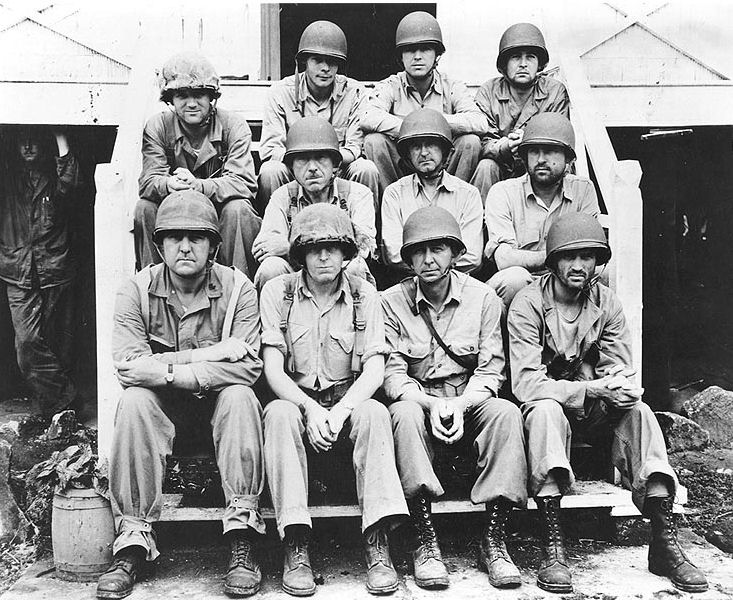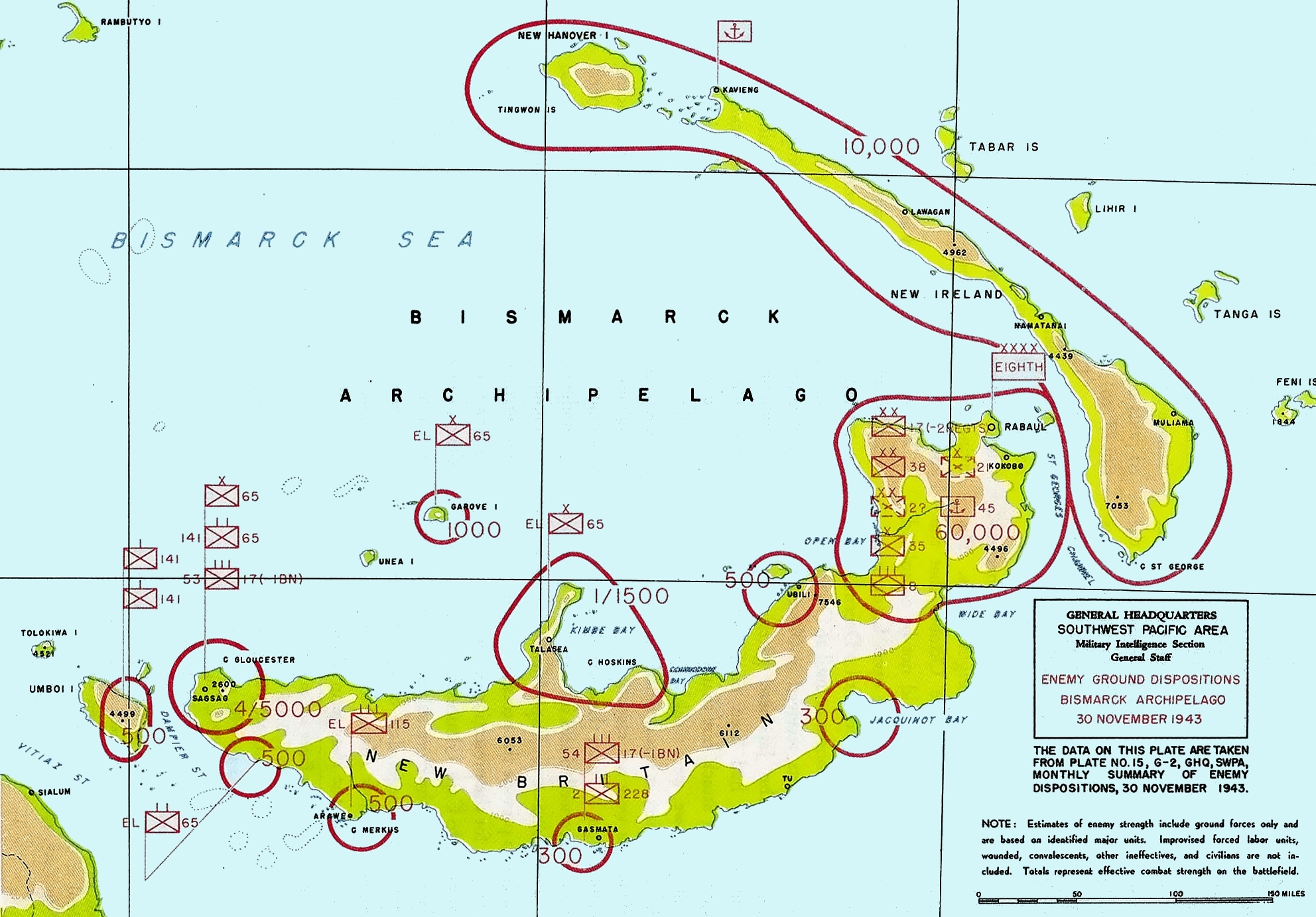|
Harold E. Rosecrans
Harold Ellett Rosecrans (March 1, 1897 – April 13, 1980) was a highly decorated officer of the United States Marine Corps with the rank of brigadier general, who commanded 2nd Battalion 5th Marines during the assault on Tulagi Island. He later commanded 17th Marine Regiment during Battle of Cape Gloucester. Early years Rosecrans was born to machinist Benjamin Rosecrans Jr. and his wife Mary Ellett on March 1, 1897, in Cohoes, New York. Following his high school graduation and United States entry into World War I, Rosecrans went to Albany, New York, and enlisted to the Marine Corps on April 20, 1917. He attended his basic training at Marine barracks within Philadelphia Navy Yard and subsequently was assigned to 23rd Company, 2nd Battalion, 5th Marine Regiment on June 3, 1917. Rosecrans and his unit were deployed to France on June 27, and, while most of his company was used to form 6th Machine Gun Battalion, he was transferred to the 55th Company, 2nd Battalion at the ... [...More Info...] [...Related Items...] OR: [Wikipedia] [Google] [Baidu] |
Cohoes, New York
Cohoes ( ) is an incorporated city located in the northeast corner of Albany County in the U.S. state of New York. It is called the "Spindle City" because of the importance of textile manufacturing to its growth in the 19th century. The city's factories processed cotton from the Deep South. As of the 2020 census, the city population was 18,174. The name Cohoes is believed to be derived from a Mohawk term, ''Ga-ha-oose'', referring to the Cohoes Falls and meaning "Place of the Falling Canoe," an interpretation noted by Horatio Gates Spafford in his 1823 publication "A Gazetteer of the State of New York". Later historians posited that the name is derived from the Algonquian ''Cohoes,'' a place name based on a word meaning 'pine tree'. History In the early years of Dutch colonial settlement, the majority of the city's territory was once part of the area of Manor of Rensselaerswyck, a feudal-style manor or patroonship. The land north of a line crossing the Cohoes Falls (today ... [...More Info...] [...Related Items...] OR: [Wikipedia] [Google] [Baidu] |
Yangtze Patrol
The Yangtze Patrol, also known as the Yangtze River Patrol Force, Yangtze River Patrol, YangPat, and ComYangPat, was a prolonged naval operation initiated after the Battle of Muddy Flat, from 1854 to 1949 to protect American interests in the Yangtze River's treaty ports. The Yangtze Patrol also patrolled the coastal waters of China where they protected U.S. citizens, their property, and Christianity in China, Christian missionaries. The Yangtze River is the longest river in China, and it plays an important commercial role, with ocean-bound vessels proceeding as far upstream as the city of Wuhan. This Squadron (naval), squadron-sized unit cruised the waters of the Yangtze from Shanghai on the Pacific Ocean into the far interior of China at Chongqing. Initially, the Yangtze Patrol was formed from ships of the United States Navy and assigned to the East India Squadron. In 1868, patrol duties were carried out by the Asiatic Squadron of the United States Navy. Under the Unequal T ... [...More Info...] [...Related Items...] OR: [Wikipedia] [Google] [Baidu] |
Machinist
A machinist is a tradesperson or trained professional who operates machine tools, and has the ability to set up tools such as milling machines, grinders, lathes, and drilling machines. A competent machinist will generally have a strong mechanical aptitude, the ability to correctly use precision measuring instruments and to interpret blueprints, and a working knowledge of the proper parameters required for successfully utilizing the various tools commonly used in machining operations. CNC (computer numerical control) comprises one of the most recent advances in manufacturing, in which a machinist uses specialized software to generate programmatic instructions (most commonly G-code) which are in turn interpreted by the machine to make components for a wide variety of industries. CNC programming is a skilled position which requires knowledge of math, speeds and feeds, machine tooling, work holding, and the different ways various materials react to stress and heat in the machining ... [...More Info...] [...Related Items...] OR: [Wikipedia] [Google] [Baidu] |
Purple Heart
The Purple Heart (PH) is a United States military decoration awarded in the name of the president to those wounded or killed while serving, on or after 5 April 1917, with the U.S. military. With its forerunner, the Badge of Military Merit, which took the form of a heart made of purple cloth, the Purple Heart is the oldest military award still given to U.S. military members. The National Purple Heart Hall of Honor is located in New Windsor, New York. History The original Purple Heart, designated as the Badge of Military Merit, was established by George Washington – then the commander-in-chief of the Continental Army – by order from his Newburgh, New York, headquarters on 7 August 1782. The Badge of Military Merit was only awarded to three Revolutionary War soldiers by Washington himself. Washington authorized his subordinate officers to issue Badges of Merit as appropriate. Although never abolished, the award of the badge was not proposed again officially ... [...More Info...] [...Related Items...] OR: [Wikipedia] [Google] [Baidu] |
Bronze Star Medal
The Bronze Star Medal (BSM) is a Awards and decorations of the United States Armed Forces, United States Armed Forces decoration awarded to members of the United States Armed Forces for either heroic achievement, heroic service, meritorious achievement, or meritorious service in a Combat, combat zone. When the medal is awarded by the United States Army, Army, United States Air Force, Air Force, or United States Space Force, Space Force for acts of valor in combat, the "V" device is authorized for wear on the medal. When the medal is awarded by the United States Navy, Navy, United States Marine Corps, Marine Corps, or United States Coast Guard, Coast Guard for acts of valor or meritorious service in combat, the "V" device#Navy, Marine Corps, and Coast Guard, Combat "V" is authorized for wear on the medal. Officers from the other Uniformed services of the United States, Uniformed Services of the United States are eligible to receive this award, as are foreign soldiers who have ... [...More Info...] [...Related Items...] OR: [Wikipedia] [Google] [Baidu] |
Legion Of Merit
The Legion of Merit (LOM) is a Awards and decorations of the United States military, military award of the United States Armed Forces that is given for exceptionally meritorious conduct in the performance of outstanding services and achievements. The decoration is issued to members of the eight uniformed services of the United States Note: National Oceanic and Atmospheric Administration Commissioned Officer Corps Amendments Act of 2012 amended the Legion of Merit to be awarded to any uniformed service. as well as to military and political figures of foreign governments. The Legion of Merit (Commander degree) is one of only two United States military decorations to be issued as a neck order (the other being the Medal of Honor), and the only United States military decoration that may be issued in degrees (much like an Order (honour), ... [...More Info...] [...Related Items...] OR: [Wikipedia] [Google] [Baidu] |
Silver Star
The Silver Star Medal (SSM) is the United States Armed Forces' third-highest military decoration for valor in combat. The Silver Star Medal is awarded primarily to members of the United States Armed Forces for gallantry in action against an enemy of the United States. History The Silver Star Medal (SSM) is the successor award to the Citation Star which was established by an Act of Congress on 9 July 1918, during World War I. On 19 July 1932, the Secretary of War approved the conversion of the Citation Star to the SSM with the original Citation Star incorporated into the center of the medal. Authorization for the Silver Star Medal was placed into law by an Act of Congress for the U.S. Navy on 7 August 1942, and an Act of Congress for the U.S. Army on 15 December 1942. The current statutory authorization for the medal is Title 10 of the United States Code, for the U.S. Army, for the U.S. Navy and U.S. Marine Corps, and for the U.S. Air Force and U.S. Space Force. Th ... [...More Info...] [...Related Items...] OR: [Wikipedia] [Google] [Baidu] |
Battle Of Okinawa
The , codenamed Operation Iceberg, was a major battle of the Pacific War fought on the island of Okinawa Island, Okinawa by United States Army and United States Marine Corps forces against the Imperial Japanese Army during the Pacific War, Imperial Japanese Army. The initial invasion of Okinawa on 1 April 1945 was the largest Amphibious warfare, amphibious assault in the Pacific Theater of World War II. The Kerama Islands surrounding Okinawa were preemptively captured on 26 March 1945 by the United States Army, U.S. Army 77th Sustainment Brigade, 77th Infantry Division. The 82-day battle on Okinawa lasted from 1 April 1945 until 22 June 1945. After a long campaign of Leapfrogging (strategy), island hopping, the Allies of World War II, Allies were planning to use Kadena Air Base on the island as a staging point for Operation Downfall, the planned invasion of the Japanese archipelago, Japanese home islands, away. The United States created the Tenth United States Army, Tenth Army ... [...More Info...] [...Related Items...] OR: [Wikipedia] [Google] [Baidu] |
Battle Of Cape Gloucester
The Battle of Cape Gloucester was fought in the Pacific theater of World War II between Japanese and Allied forces on the island of New Britain, Territory of New Guinea, between 26 December 1943 and 16 January 1944. Codenamed Operation Backhander, the US landing formed part of the wider Operation Cartwheel, the main Allied strategy in the South West Pacific Area and Pacific Ocean Areas during 1943–1944. It was the second landing the US 1st Marine Division had conducted during the war thus far, after Guadalcanal. The objective of the operation was to capture the two Japanese airfields near Cape Gloucester that were defended by elements of the Japanese 17th Division. The main landing came on 26 December 1943, when US Marines landed on either side of the peninsula. The western landing force acted as a diversion and cut the coastal road near Tauali to restrict Japanese freedom of movement, while the main force—landing on the eastern side—advanced north towards the airfiel ... [...More Info...] [...Related Items...] OR: [Wikipedia] [Google] [Baidu] |
New Britain Campaign
The New Britain campaign was a World War II campaign fought between Allies of World War II, Allied and Empire of Japan, Imperial Japanese forces. The campaign was initiated by the Allies in late 1943 as part of a major offensive which aimed to neutralise the important Japanese base at Rabaul, the capital of New Britain, and was conducted in two phases between December 1943 and the end of the war in August 1945. Initial fighting on New Britain took place around the western end of the island in December 1943 and January 1944, with US forces landing and securing bases around Battle of Arawe, Arawe and Battle of Cape Gloucester, Cape Gloucester. This was followed by a further landing in March 1944 around Battle of Talasea, Talasea, after which little fighting took place between the ground forces on the island. In October 1944, the 5th Division (Australia), Australian 5th Division took over from the US troops and undertook a landing at Jacquinot Bay the following month, before beginni ... [...More Info...] [...Related Items...] OR: [Wikipedia] [Google] [Baidu] |
Solomon Islands Campaign
The Solomon Islands campaign was a major military campaign, campaign of the Pacific War during World War II. The campaign began with the Empire of Japan, Japanese seizure of several areas in the British Solomon Islands and Bougainville Island, Bougainville, in the Territory of New Guinea, during the first six months of 1942. Japanese troops subsequently began the construction of several naval and air bases in the area. Japan's initial goals were to protect the flank of their ongoing offensive in New Guinea, establish a security barrier for the major Japanese base at Rabaul on New Britain, and construct bases from which they could interdict supply lines between the Allies of World War II, Allied powers of the United States and Australia and Dominion of New Zealand, New Zealand. In order to defend their communication and supply lines in the Pacific Ocean, South Pacific, the Allies initiated a counteroffensive in New Guinea and counterattacked Japanese forces in the Solomons via lan ... [...More Info...] [...Related Items...] OR: [Wikipedia] [Google] [Baidu] |
Battle Of Tulagi And Gavutu–Tanambogo
The Battle of Tulagi and Gavutu–Tanambogo was a land battle of the Pacific War, Pacific campaign of World War II, between the forces of the Imperial Japanese Navy and Allies of World War II, Allied (mainly United States Marine Corps) ground forces. It took place 7–9 August 1942 on the Solomon Islands, during the initial Allied landings in the Guadalcanal campaign. U.S. Marines of the 1st Marine Division, commanded by U.S. Major General Alexander Vandegrift, and the invasion force under Brigadier General William H. Rupertus, William Rupertus, captured the islands of Tulagi, Gavutu, and Tanambogo. The Japanese Navy had built a naval and seaplane base on these islands. The landings were fiercely resisted by the Japanese Navy troops who, heavily outnumbered and outgunned by the Allied forces, fought and died almost to the last man. While the landings on Tulagi and Gavutu–Tanambogo were taking place, Allied troops were also landing on nearby Guadalcanal, with the objective of c ... [...More Info...] [...Related Items...] OR: [Wikipedia] [Google] [Baidu] |









